HI6008 Business Research: Investigating Fast Food and Obesity
VerifiedAdded on 2023/06/07
|13
|3198
|325
Report
AI Summary
This business research report investigates the relationship between fast food consumption and obesity levels. It outlines the project's objectives, which include identifying fast food consumption levels, understanding the interrelationship between fast food diets and health, determining issues with fast food consumption, and identifying measures to reduce consumption and obesity. The report includes a literature review highlighting the increasing prevalence of obesity and its links to fast food, examining factors like calorie intake, lifestyle changes, and marketing tactics. It identifies a gap in the literature regarding other related diseases and proposes both qualitative and quantitative research methodologies, including surveys and data analysis, to explore the correlation between fast food and obesity. The research aims to provide insights into addressing the public health concern of obesity related to fast food consumption.
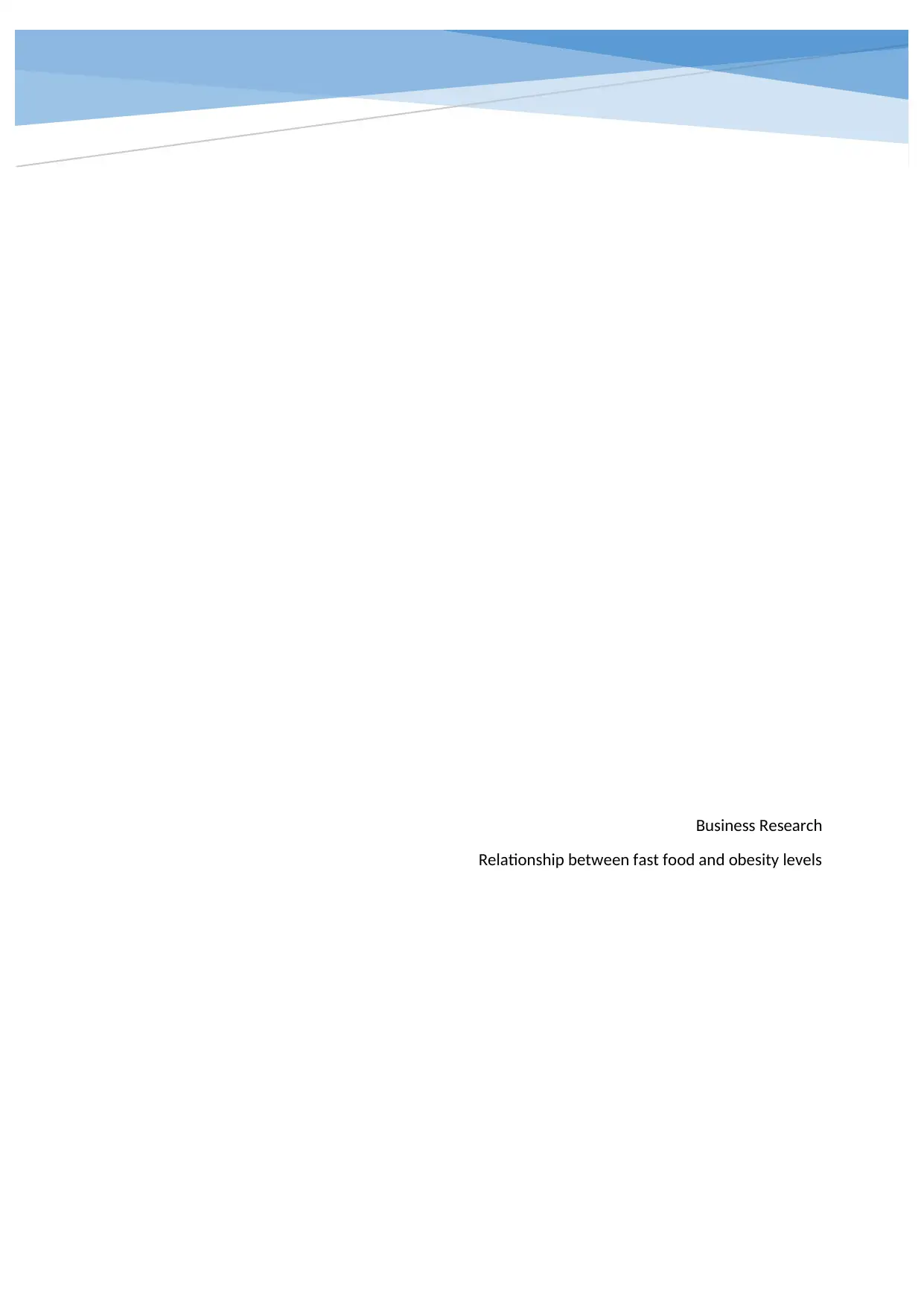
Business Research
Relationship between fast food and obesity levels
Relationship between fast food and obesity levels
Paraphrase This Document
Need a fresh take? Get an instant paraphrase of this document with our AI Paraphraser
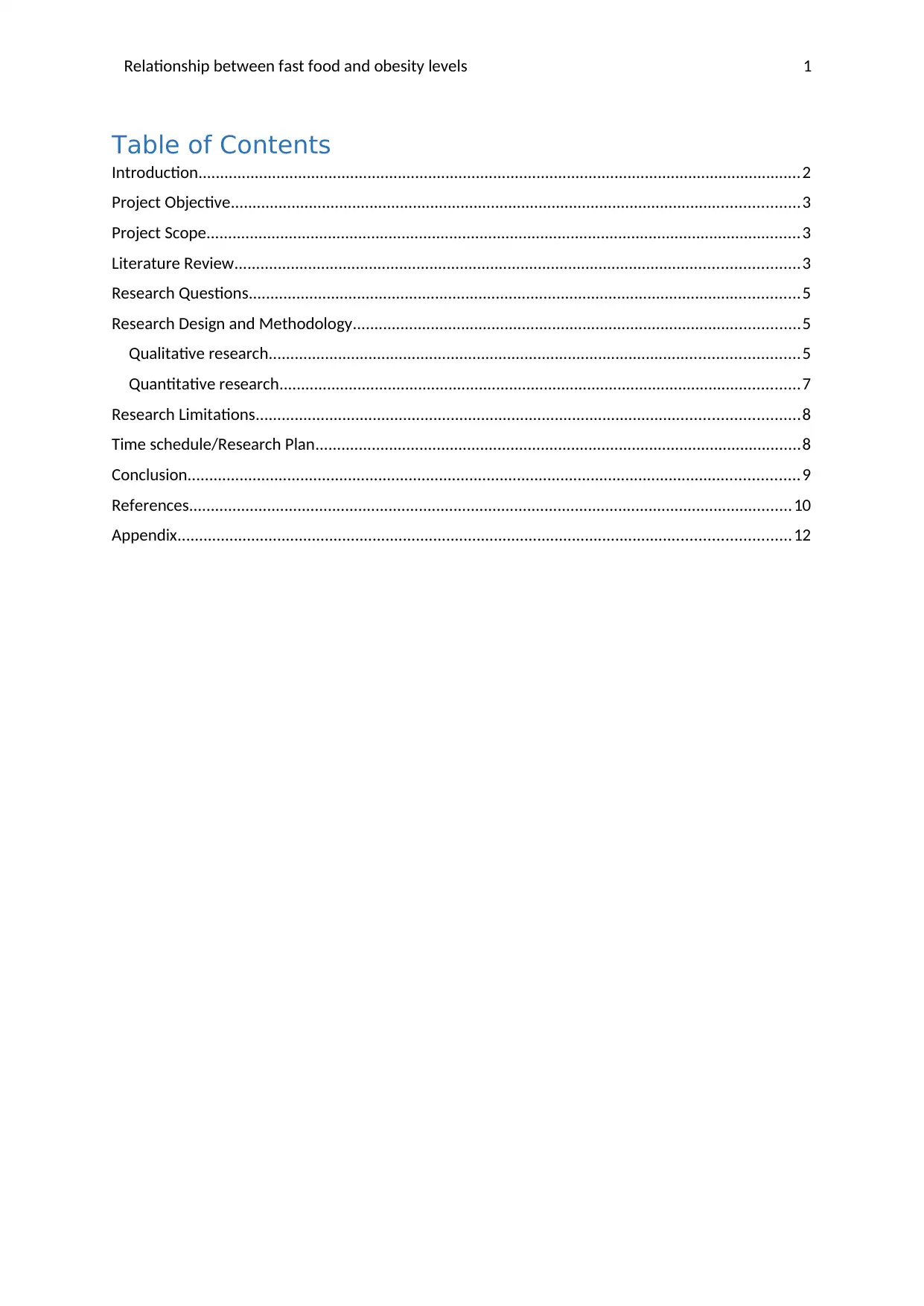
Relationship between fast food and obesity levels 1
Table of Contents
Introduction...........................................................................................................................................2
Project Objective...................................................................................................................................3
Project Scope.........................................................................................................................................3
Literature Review..................................................................................................................................3
Research Questions...............................................................................................................................5
Research Design and Methodology.......................................................................................................5
Qualitative research..........................................................................................................................5
Quantitative research........................................................................................................................7
Research Limitations.............................................................................................................................8
Time schedule/Research Plan................................................................................................................8
Conclusion.............................................................................................................................................9
References...........................................................................................................................................10
Appendix.............................................................................................................................................12
Table of Contents
Introduction...........................................................................................................................................2
Project Objective...................................................................................................................................3
Project Scope.........................................................................................................................................3
Literature Review..................................................................................................................................3
Research Questions...............................................................................................................................5
Research Design and Methodology.......................................................................................................5
Qualitative research..........................................................................................................................5
Quantitative research........................................................................................................................7
Research Limitations.............................................................................................................................8
Time schedule/Research Plan................................................................................................................8
Conclusion.............................................................................................................................................9
References...........................................................................................................................................10
Appendix.............................................................................................................................................12
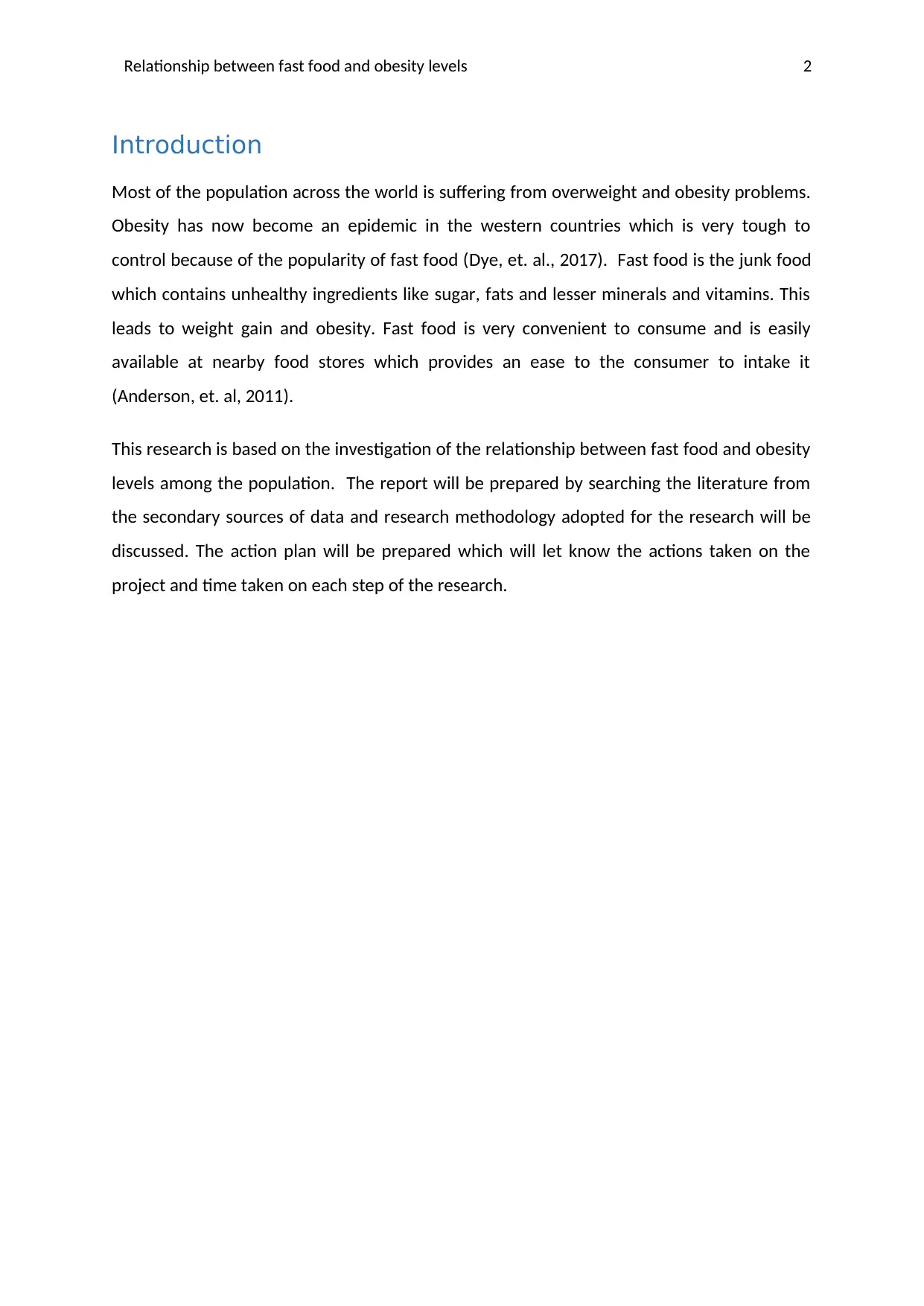
Relationship between fast food and obesity levels 2
Introduction
Most of the population across the world is suffering from overweight and obesity problems.
Obesity has now become an epidemic in the western countries which is very tough to
control because of the popularity of fast food (Dye, et. al., 2017). Fast food is the junk food
which contains unhealthy ingredients like sugar, fats and lesser minerals and vitamins. This
leads to weight gain and obesity. Fast food is very convenient to consume and is easily
available at nearby food stores which provides an ease to the consumer to intake it
(Anderson, et. al, 2011).
This research is based on the investigation of the relationship between fast food and obesity
levels among the population. The report will be prepared by searching the literature from
the secondary sources of data and research methodology adopted for the research will be
discussed. The action plan will be prepared which will let know the actions taken on the
project and time taken on each step of the research.
Introduction
Most of the population across the world is suffering from overweight and obesity problems.
Obesity has now become an epidemic in the western countries which is very tough to
control because of the popularity of fast food (Dye, et. al., 2017). Fast food is the junk food
which contains unhealthy ingredients like sugar, fats and lesser minerals and vitamins. This
leads to weight gain and obesity. Fast food is very convenient to consume and is easily
available at nearby food stores which provides an ease to the consumer to intake it
(Anderson, et. al, 2011).
This research is based on the investigation of the relationship between fast food and obesity
levels among the population. The report will be prepared by searching the literature from
the secondary sources of data and research methodology adopted for the research will be
discussed. The action plan will be prepared which will let know the actions taken on the
project and time taken on each step of the research.
⊘ This is a preview!⊘
Do you want full access?
Subscribe today to unlock all pages.

Trusted by 1+ million students worldwide
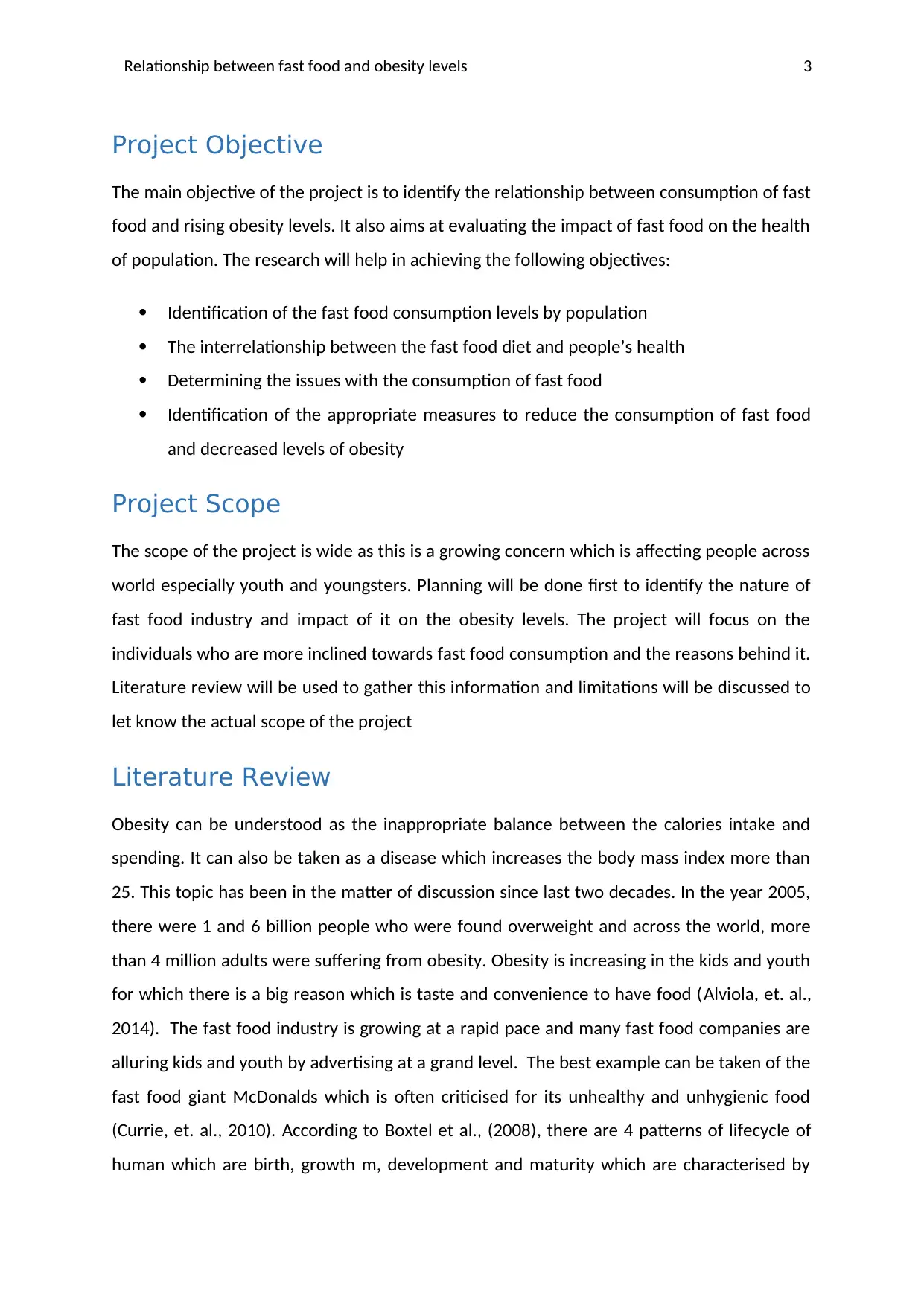
Relationship between fast food and obesity levels 3
Project Objective
The main objective of the project is to identify the relationship between consumption of fast
food and rising obesity levels. It also aims at evaluating the impact of fast food on the health
of population. The research will help in achieving the following objectives:
Identification of the fast food consumption levels by population
The interrelationship between the fast food diet and people’s health
Determining the issues with the consumption of fast food
Identification of the appropriate measures to reduce the consumption of fast food
and decreased levels of obesity
Project Scope
The scope of the project is wide as this is a growing concern which is affecting people across
world especially youth and youngsters. Planning will be done first to identify the nature of
fast food industry and impact of it on the obesity levels. The project will focus on the
individuals who are more inclined towards fast food consumption and the reasons behind it.
Literature review will be used to gather this information and limitations will be discussed to
let know the actual scope of the project
Literature Review
Obesity can be understood as the inappropriate balance between the calories intake and
spending. It can also be taken as a disease which increases the body mass index more than
25. This topic has been in the matter of discussion since last two decades. In the year 2005,
there were 1 and 6 billion people who were found overweight and across the world, more
than 4 million adults were suffering from obesity. Obesity is increasing in the kids and youth
for which there is a big reason which is taste and convenience to have food (Alviola, et. al.,
2014). The fast food industry is growing at a rapid pace and many fast food companies are
alluring kids and youth by advertising at a grand level. The best example can be taken of the
fast food giant McDonalds which is often criticised for its unhealthy and unhygienic food
(Currie, et. al., 2010). According to Boxtel et al., (2008), there are 4 patterns of lifecycle of
human which are birth, growth m, development and maturity which are characterised by
Project Objective
The main objective of the project is to identify the relationship between consumption of fast
food and rising obesity levels. It also aims at evaluating the impact of fast food on the health
of population. The research will help in achieving the following objectives:
Identification of the fast food consumption levels by population
The interrelationship between the fast food diet and people’s health
Determining the issues with the consumption of fast food
Identification of the appropriate measures to reduce the consumption of fast food
and decreased levels of obesity
Project Scope
The scope of the project is wide as this is a growing concern which is affecting people across
world especially youth and youngsters. Planning will be done first to identify the nature of
fast food industry and impact of it on the obesity levels. The project will focus on the
individuals who are more inclined towards fast food consumption and the reasons behind it.
Literature review will be used to gather this information and limitations will be discussed to
let know the actual scope of the project
Literature Review
Obesity can be understood as the inappropriate balance between the calories intake and
spending. It can also be taken as a disease which increases the body mass index more than
25. This topic has been in the matter of discussion since last two decades. In the year 2005,
there were 1 and 6 billion people who were found overweight and across the world, more
than 4 million adults were suffering from obesity. Obesity is increasing in the kids and youth
for which there is a big reason which is taste and convenience to have food (Alviola, et. al.,
2014). The fast food industry is growing at a rapid pace and many fast food companies are
alluring kids and youth by advertising at a grand level. The best example can be taken of the
fast food giant McDonalds which is often criticised for its unhealthy and unhygienic food
(Currie, et. al., 2010). According to Boxtel et al., (2008), there are 4 patterns of lifecycle of
human which are birth, growth m, development and maturity which are characterised by
Paraphrase This Document
Need a fresh take? Get an instant paraphrase of this document with our AI Paraphraser
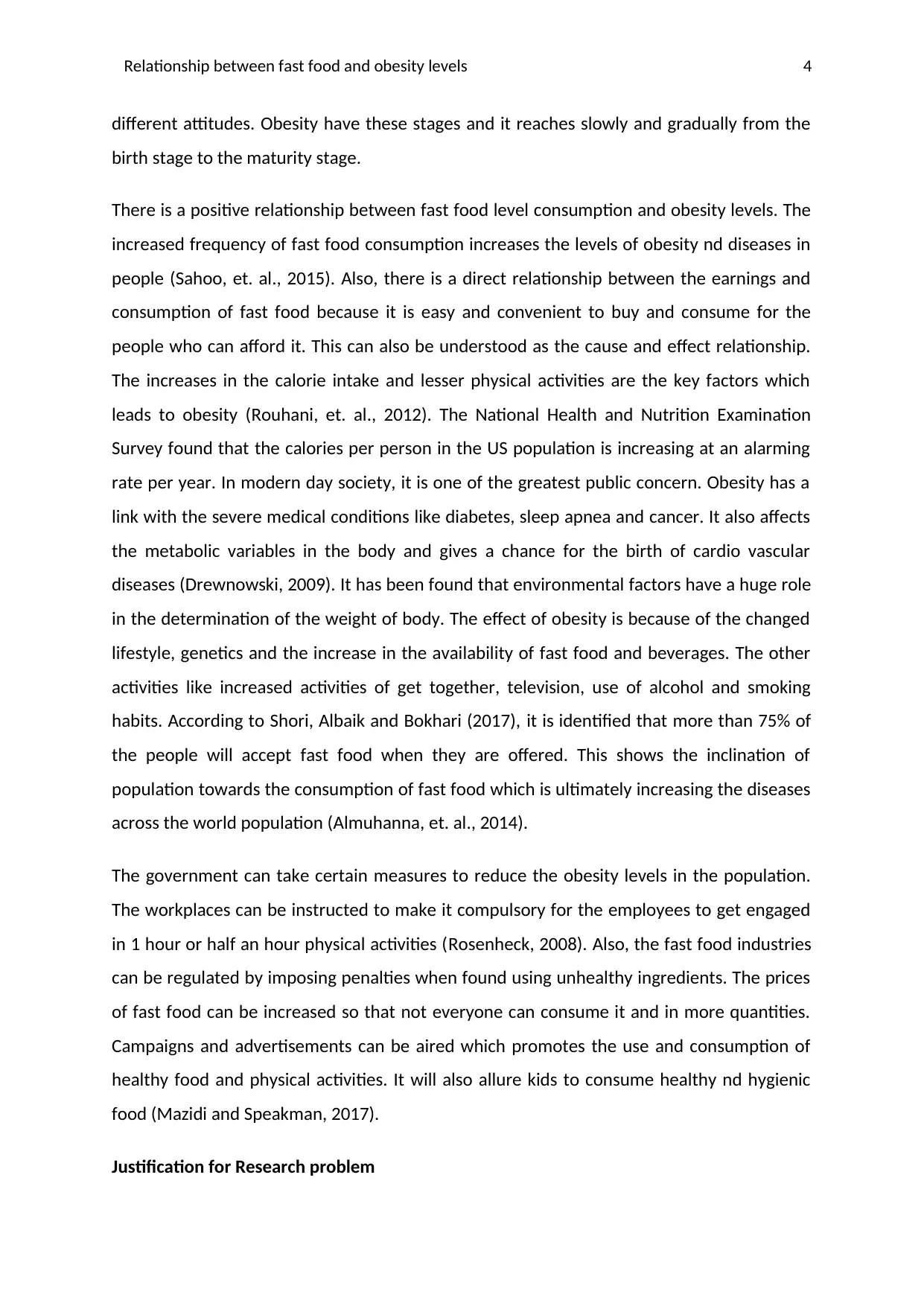
Relationship between fast food and obesity levels 4
different attitudes. Obesity have these stages and it reaches slowly and gradually from the
birth stage to the maturity stage.
There is a positive relationship between fast food level consumption and obesity levels. The
increased frequency of fast food consumption increases the levels of obesity nd diseases in
people (Sahoo, et. al., 2015). Also, there is a direct relationship between the earnings and
consumption of fast food because it is easy and convenient to buy and consume for the
people who can afford it. This can also be understood as the cause and effect relationship.
The increases in the calorie intake and lesser physical activities are the key factors which
leads to obesity (Rouhani, et. al., 2012). The National Health and Nutrition Examination
Survey found that the calories per person in the US population is increasing at an alarming
rate per year. In modern day society, it is one of the greatest public concern. Obesity has a
link with the severe medical conditions like diabetes, sleep apnea and cancer. It also affects
the metabolic variables in the body and gives a chance for the birth of cardio vascular
diseases (Drewnowski, 2009). It has been found that environmental factors have a huge role
in the determination of the weight of body. The effect of obesity is because of the changed
lifestyle, genetics and the increase in the availability of fast food and beverages. The other
activities like increased activities of get together, television, use of alcohol and smoking
habits. According to Shori, Albaik and Bokhari (2017), it is identified that more than 75% of
the people will accept fast food when they are offered. This shows the inclination of
population towards the consumption of fast food which is ultimately increasing the diseases
across the world population (Almuhanna, et. al., 2014).
The government can take certain measures to reduce the obesity levels in the population.
The workplaces can be instructed to make it compulsory for the employees to get engaged
in 1 hour or half an hour physical activities (Rosenheck, 2008). Also, the fast food industries
can be regulated by imposing penalties when found using unhealthy ingredients. The prices
of fast food can be increased so that not everyone can consume it and in more quantities.
Campaigns and advertisements can be aired which promotes the use and consumption of
healthy food and physical activities. It will also allure kids to consume healthy nd hygienic
food (Mazidi and Speakman, 2017).
Justification for Research problem
different attitudes. Obesity have these stages and it reaches slowly and gradually from the
birth stage to the maturity stage.
There is a positive relationship between fast food level consumption and obesity levels. The
increased frequency of fast food consumption increases the levels of obesity nd diseases in
people (Sahoo, et. al., 2015). Also, there is a direct relationship between the earnings and
consumption of fast food because it is easy and convenient to buy and consume for the
people who can afford it. This can also be understood as the cause and effect relationship.
The increases in the calorie intake and lesser physical activities are the key factors which
leads to obesity (Rouhani, et. al., 2012). The National Health and Nutrition Examination
Survey found that the calories per person in the US population is increasing at an alarming
rate per year. In modern day society, it is one of the greatest public concern. Obesity has a
link with the severe medical conditions like diabetes, sleep apnea and cancer. It also affects
the metabolic variables in the body and gives a chance for the birth of cardio vascular
diseases (Drewnowski, 2009). It has been found that environmental factors have a huge role
in the determination of the weight of body. The effect of obesity is because of the changed
lifestyle, genetics and the increase in the availability of fast food and beverages. The other
activities like increased activities of get together, television, use of alcohol and smoking
habits. According to Shori, Albaik and Bokhari (2017), it is identified that more than 75% of
the people will accept fast food when they are offered. This shows the inclination of
population towards the consumption of fast food which is ultimately increasing the diseases
across the world population (Almuhanna, et. al., 2014).
The government can take certain measures to reduce the obesity levels in the population.
The workplaces can be instructed to make it compulsory for the employees to get engaged
in 1 hour or half an hour physical activities (Rosenheck, 2008). Also, the fast food industries
can be regulated by imposing penalties when found using unhealthy ingredients. The prices
of fast food can be increased so that not everyone can consume it and in more quantities.
Campaigns and advertisements can be aired which promotes the use and consumption of
healthy food and physical activities. It will also allure kids to consume healthy nd hygienic
food (Mazidi and Speakman, 2017).
Justification for Research problem

Relationship between fast food and obesity levels 5
The consumption of fast food has increases lot over the years. People are provided with the
food items with no information of calorie ingredients in them. There are more than 36% of
adults and 425 of children who take lot of calories but very less amount of vitamins and
minerals. Fast food consumption have increased because of the attractive advertisements
and promotions on television and internet. Because of this, kids gets obsessed with the
consumption of fast food and they long for taste rather than going for homemade food
which is healthy nd fresh. This why, the youth is facing challenges and are facing various
diseases like Cancer, heart attacks and diabetes (Finkelstein,et. al., 2012).
Literature Gap
By going through the whole literature, it is made clear that the relationship between these
two variables i.e. the obesity levels and fast food consumption is direct nd positive. When
fast food consumption rises, obesity levels also rise with the other diseases. The literature
lacks the data collected about the other diseases which could have been covered in the
research. The literature helped on understanding the present scenario of obesity and how it
is affecting the world population specially kids and their future. For more understanding of
the research, the methodology will be discussed.
Research Questions
Primary Question
What is the relationship between the consumption of fast food and obesity levels?
Secondary question
What are the issues with the consumption of fast food?
How the consumption of fast food can be reduced so that the health problems can be
reduced among youngsters and adults?
Research Design and Methodology
Qualitative research
The process
The consumption of fast food has increases lot over the years. People are provided with the
food items with no information of calorie ingredients in them. There are more than 36% of
adults and 425 of children who take lot of calories but very less amount of vitamins and
minerals. Fast food consumption have increased because of the attractive advertisements
and promotions on television and internet. Because of this, kids gets obsessed with the
consumption of fast food and they long for taste rather than going for homemade food
which is healthy nd fresh. This why, the youth is facing challenges and are facing various
diseases like Cancer, heart attacks and diabetes (Finkelstein,et. al., 2012).
Literature Gap
By going through the whole literature, it is made clear that the relationship between these
two variables i.e. the obesity levels and fast food consumption is direct nd positive. When
fast food consumption rises, obesity levels also rise with the other diseases. The literature
lacks the data collected about the other diseases which could have been covered in the
research. The literature helped on understanding the present scenario of obesity and how it
is affecting the world population specially kids and their future. For more understanding of
the research, the methodology will be discussed.
Research Questions
Primary Question
What is the relationship between the consumption of fast food and obesity levels?
Secondary question
What are the issues with the consumption of fast food?
How the consumption of fast food can be reduced so that the health problems can be
reduced among youngsters and adults?
Research Design and Methodology
Qualitative research
The process
⊘ This is a preview!⊘
Do you want full access?
Subscribe today to unlock all pages.

Trusted by 1+ million students worldwide
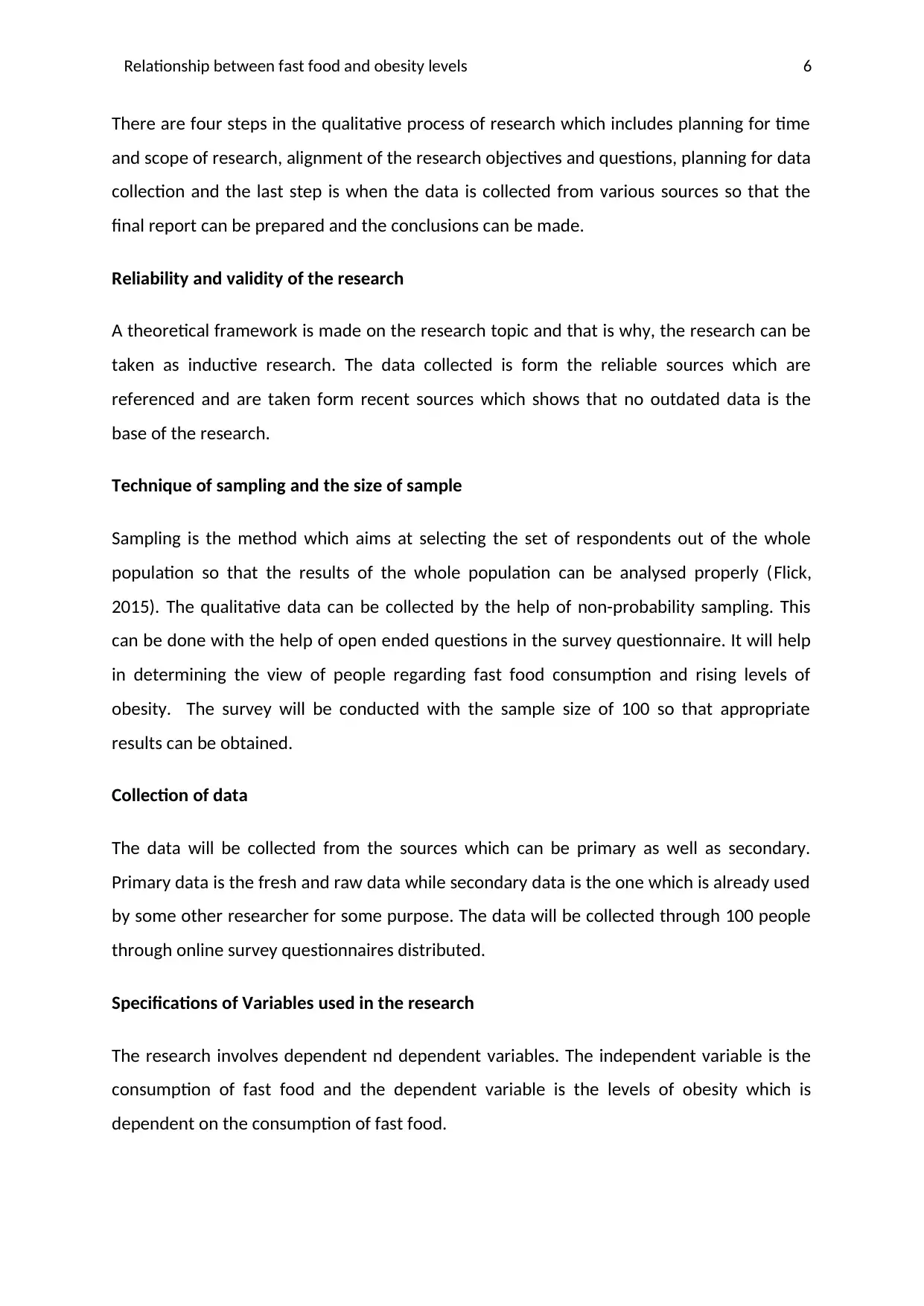
Relationship between fast food and obesity levels 6
There are four steps in the qualitative process of research which includes planning for time
and scope of research, alignment of the research objectives and questions, planning for data
collection and the last step is when the data is collected from various sources so that the
final report can be prepared and the conclusions can be made.
Reliability and validity of the research
A theoretical framework is made on the research topic and that is why, the research can be
taken as inductive research. The data collected is form the reliable sources which are
referenced and are taken form recent sources which shows that no outdated data is the
base of the research.
Technique of sampling and the size of sample
Sampling is the method which aims at selecting the set of respondents out of the whole
population so that the results of the whole population can be analysed properly (Flick,
2015). The qualitative data can be collected by the help of non-probability sampling. This
can be done with the help of open ended questions in the survey questionnaire. It will help
in determining the view of people regarding fast food consumption and rising levels of
obesity. The survey will be conducted with the sample size of 100 so that appropriate
results can be obtained.
Collection of data
The data will be collected from the sources which can be primary as well as secondary.
Primary data is the fresh and raw data while secondary data is the one which is already used
by some other researcher for some purpose. The data will be collected through 100 people
through online survey questionnaires distributed.
Specifications of Variables used in the research
The research involves dependent nd dependent variables. The independent variable is the
consumption of fast food and the dependent variable is the levels of obesity which is
dependent on the consumption of fast food.
There are four steps in the qualitative process of research which includes planning for time
and scope of research, alignment of the research objectives and questions, planning for data
collection and the last step is when the data is collected from various sources so that the
final report can be prepared and the conclusions can be made.
Reliability and validity of the research
A theoretical framework is made on the research topic and that is why, the research can be
taken as inductive research. The data collected is form the reliable sources which are
referenced and are taken form recent sources which shows that no outdated data is the
base of the research.
Technique of sampling and the size of sample
Sampling is the method which aims at selecting the set of respondents out of the whole
population so that the results of the whole population can be analysed properly (Flick,
2015). The qualitative data can be collected by the help of non-probability sampling. This
can be done with the help of open ended questions in the survey questionnaire. It will help
in determining the view of people regarding fast food consumption and rising levels of
obesity. The survey will be conducted with the sample size of 100 so that appropriate
results can be obtained.
Collection of data
The data will be collected from the sources which can be primary as well as secondary.
Primary data is the fresh and raw data while secondary data is the one which is already used
by some other researcher for some purpose. The data will be collected through 100 people
through online survey questionnaires distributed.
Specifications of Variables used in the research
The research involves dependent nd dependent variables. The independent variable is the
consumption of fast food and the dependent variable is the levels of obesity which is
dependent on the consumption of fast food.
Paraphrase This Document
Need a fresh take? Get an instant paraphrase of this document with our AI Paraphraser
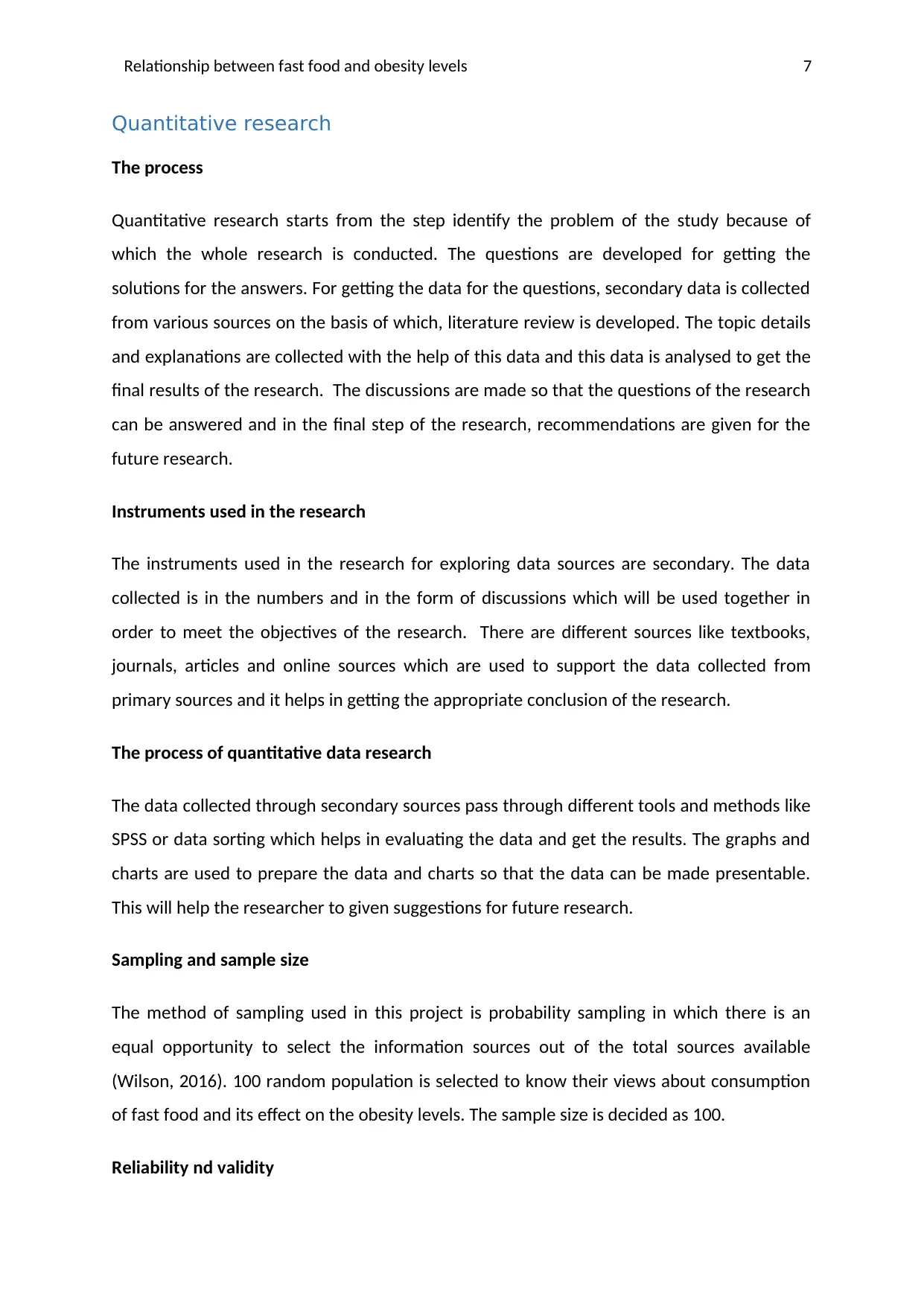
Relationship between fast food and obesity levels 7
Quantitative research
The process
Quantitative research starts from the step identify the problem of the study because of
which the whole research is conducted. The questions are developed for getting the
solutions for the answers. For getting the data for the questions, secondary data is collected
from various sources on the basis of which, literature review is developed. The topic details
and explanations are collected with the help of this data and this data is analysed to get the
final results of the research. The discussions are made so that the questions of the research
can be answered and in the final step of the research, recommendations are given for the
future research.
Instruments used in the research
The instruments used in the research for exploring data sources are secondary. The data
collected is in the numbers and in the form of discussions which will be used together in
order to meet the objectives of the research. There are different sources like textbooks,
journals, articles and online sources which are used to support the data collected from
primary sources and it helps in getting the appropriate conclusion of the research.
The process of quantitative data research
The data collected through secondary sources pass through different tools and methods like
SPSS or data sorting which helps in evaluating the data and get the results. The graphs and
charts are used to prepare the data and charts so that the data can be made presentable.
This will help the researcher to given suggestions for future research.
Sampling and sample size
The method of sampling used in this project is probability sampling in which there is an
equal opportunity to select the information sources out of the total sources available
(Wilson, 2016). 100 random population is selected to know their views about consumption
of fast food and its effect on the obesity levels. The sample size is decided as 100.
Reliability nd validity
Quantitative research
The process
Quantitative research starts from the step identify the problem of the study because of
which the whole research is conducted. The questions are developed for getting the
solutions for the answers. For getting the data for the questions, secondary data is collected
from various sources on the basis of which, literature review is developed. The topic details
and explanations are collected with the help of this data and this data is analysed to get the
final results of the research. The discussions are made so that the questions of the research
can be answered and in the final step of the research, recommendations are given for the
future research.
Instruments used in the research
The instruments used in the research for exploring data sources are secondary. The data
collected is in the numbers and in the form of discussions which will be used together in
order to meet the objectives of the research. There are different sources like textbooks,
journals, articles and online sources which are used to support the data collected from
primary sources and it helps in getting the appropriate conclusion of the research.
The process of quantitative data research
The data collected through secondary sources pass through different tools and methods like
SPSS or data sorting which helps in evaluating the data and get the results. The graphs and
charts are used to prepare the data and charts so that the data can be made presentable.
This will help the researcher to given suggestions for future research.
Sampling and sample size
The method of sampling used in this project is probability sampling in which there is an
equal opportunity to select the information sources out of the total sources available
(Wilson, 2016). 100 random population is selected to know their views about consumption
of fast food and its effect on the obesity levels. The sample size is decided as 100.
Reliability nd validity
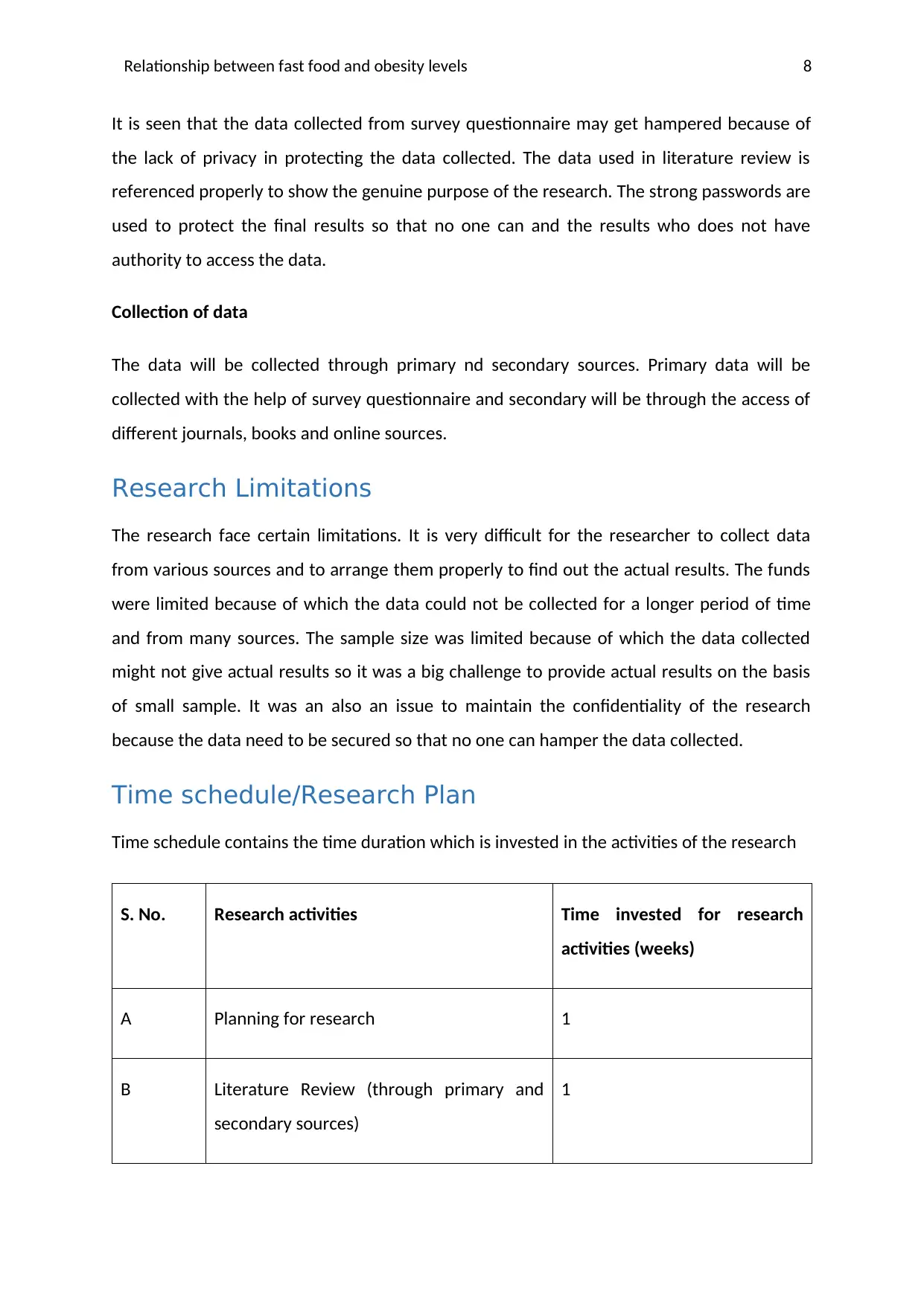
Relationship between fast food and obesity levels 8
It is seen that the data collected from survey questionnaire may get hampered because of
the lack of privacy in protecting the data collected. The data used in literature review is
referenced properly to show the genuine purpose of the research. The strong passwords are
used to protect the final results so that no one can and the results who does not have
authority to access the data.
Collection of data
The data will be collected through primary nd secondary sources. Primary data will be
collected with the help of survey questionnaire and secondary will be through the access of
different journals, books and online sources.
Research Limitations
The research face certain limitations. It is very difficult for the researcher to collect data
from various sources and to arrange them properly to find out the actual results. The funds
were limited because of which the data could not be collected for a longer period of time
and from many sources. The sample size was limited because of which the data collected
might not give actual results so it was a big challenge to provide actual results on the basis
of small sample. It was an also an issue to maintain the confidentiality of the research
because the data need to be secured so that no one can hamper the data collected.
Time schedule/Research Plan
Time schedule contains the time duration which is invested in the activities of the research
S. No. Research activities Time invested for research
activities (weeks)
A Planning for research 1
B Literature Review (through primary and
secondary sources)
1
It is seen that the data collected from survey questionnaire may get hampered because of
the lack of privacy in protecting the data collected. The data used in literature review is
referenced properly to show the genuine purpose of the research. The strong passwords are
used to protect the final results so that no one can and the results who does not have
authority to access the data.
Collection of data
The data will be collected through primary nd secondary sources. Primary data will be
collected with the help of survey questionnaire and secondary will be through the access of
different journals, books and online sources.
Research Limitations
The research face certain limitations. It is very difficult for the researcher to collect data
from various sources and to arrange them properly to find out the actual results. The funds
were limited because of which the data could not be collected for a longer period of time
and from many sources. The sample size was limited because of which the data collected
might not give actual results so it was a big challenge to provide actual results on the basis
of small sample. It was an also an issue to maintain the confidentiality of the research
because the data need to be secured so that no one can hamper the data collected.
Time schedule/Research Plan
Time schedule contains the time duration which is invested in the activities of the research
S. No. Research activities Time invested for research
activities (weeks)
A Planning for research 1
B Literature Review (through primary and
secondary sources)
1
⊘ This is a preview!⊘
Do you want full access?
Subscribe today to unlock all pages.

Trusted by 1+ million students worldwide
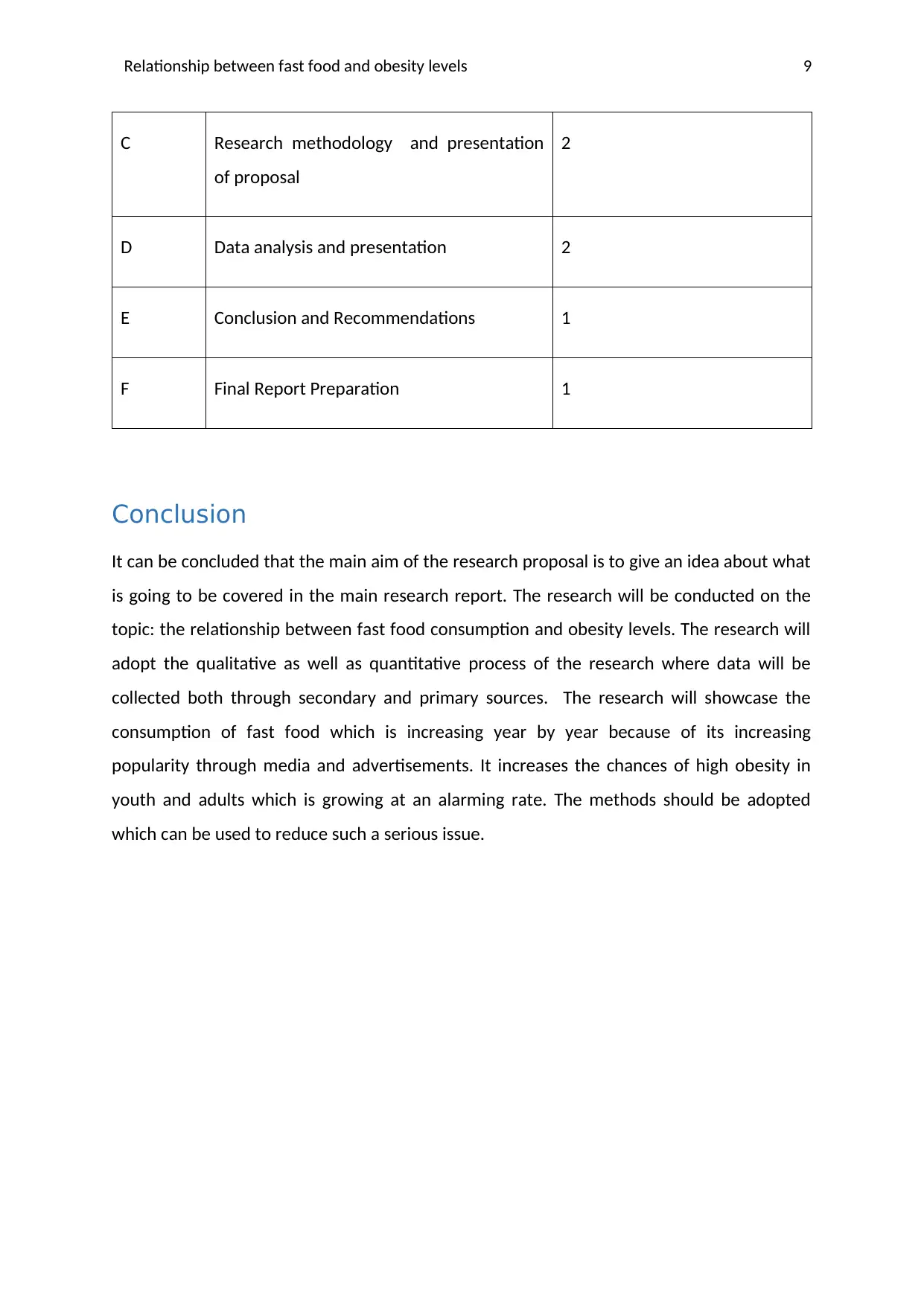
Relationship between fast food and obesity levels 9
C Research methodology and presentation
of proposal
2
D Data analysis and presentation 2
E Conclusion and Recommendations 1
F Final Report Preparation 1
Conclusion
It can be concluded that the main aim of the research proposal is to give an idea about what
is going to be covered in the main research report. The research will be conducted on the
topic: the relationship between fast food consumption and obesity levels. The research will
adopt the qualitative as well as quantitative process of the research where data will be
collected both through secondary and primary sources. The research will showcase the
consumption of fast food which is increasing year by year because of its increasing
popularity through media and advertisements. It increases the chances of high obesity in
youth and adults which is growing at an alarming rate. The methods should be adopted
which can be used to reduce such a serious issue.
C Research methodology and presentation
of proposal
2
D Data analysis and presentation 2
E Conclusion and Recommendations 1
F Final Report Preparation 1
Conclusion
It can be concluded that the main aim of the research proposal is to give an idea about what
is going to be covered in the main research report. The research will be conducted on the
topic: the relationship between fast food consumption and obesity levels. The research will
adopt the qualitative as well as quantitative process of the research where data will be
collected both through secondary and primary sources. The research will showcase the
consumption of fast food which is increasing year by year because of its increasing
popularity through media and advertisements. It increases the chances of high obesity in
youth and adults which is growing at an alarming rate. The methods should be adopted
which can be used to reduce such a serious issue.
Paraphrase This Document
Need a fresh take? Get an instant paraphrase of this document with our AI Paraphraser
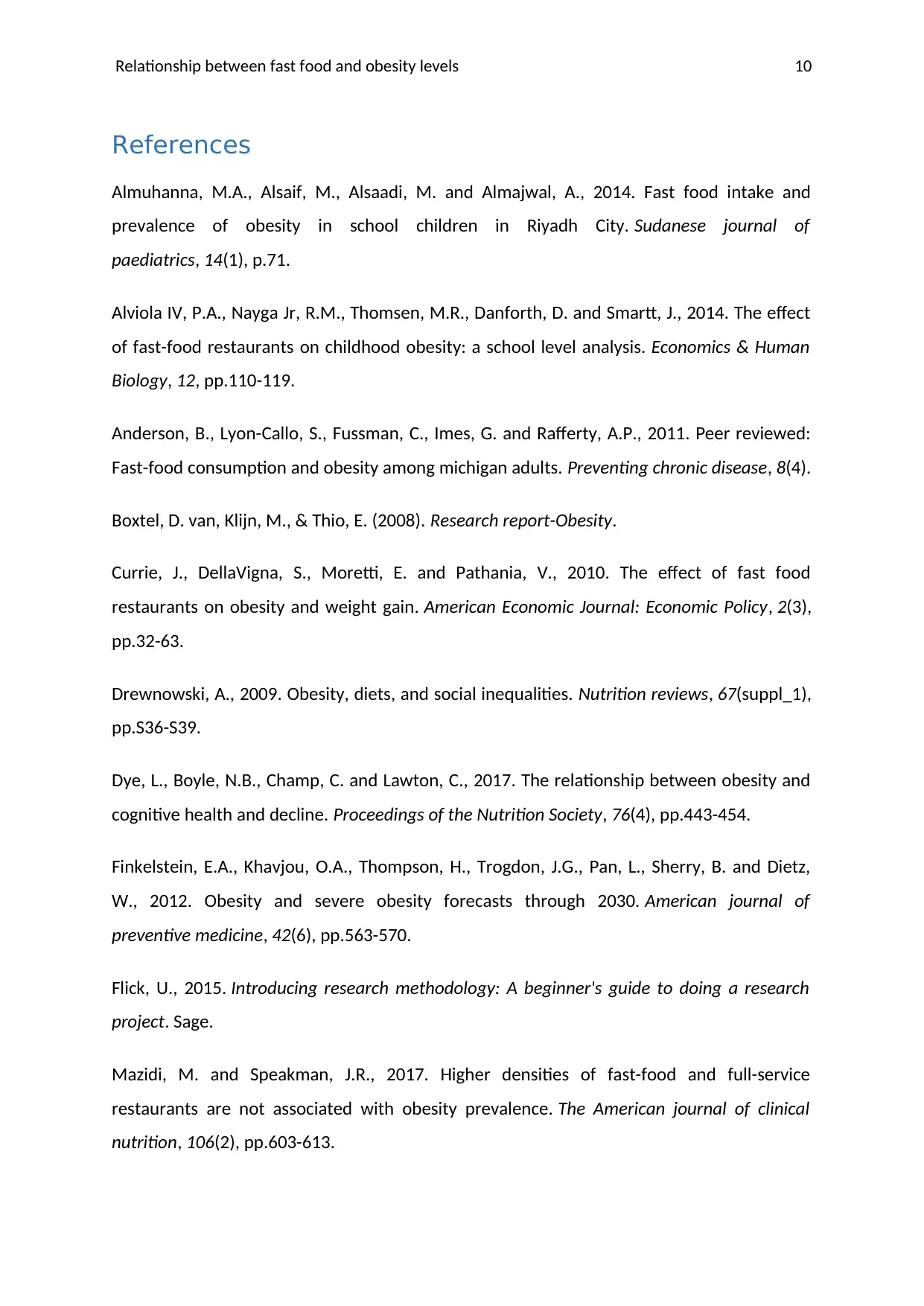
Relationship between fast food and obesity levels 10
References
Almuhanna, M.A., Alsaif, M., Alsaadi, M. and Almajwal, A., 2014. Fast food intake and
prevalence of obesity in school children in Riyadh City. Sudanese journal of
paediatrics, 14(1), p.71.
Alviola IV, P.A., Nayga Jr, R.M., Thomsen, M.R., Danforth, D. and Smartt, J., 2014. The effect
of fast-food restaurants on childhood obesity: a school level analysis. Economics & Human
Biology, 12, pp.110-119.
Anderson, B., Lyon-Callo, S., Fussman, C., Imes, G. and Rafferty, A.P., 2011. Peer reviewed:
Fast-food consumption and obesity among michigan adults. Preventing chronic disease, 8(4).
Boxtel, D. van, Klijn, M., & Thio, E. (2008). Research report-Obesity.
Currie, J., DellaVigna, S., Moretti, E. and Pathania, V., 2010. The effect of fast food
restaurants on obesity and weight gain. American Economic Journal: Economic Policy, 2(3),
pp.32-63.
Drewnowski, A., 2009. Obesity, diets, and social inequalities. Nutrition reviews, 67(suppl_1),
pp.S36-S39.
Dye, L., Boyle, N.B., Champ, C. and Lawton, C., 2017. The relationship between obesity and
cognitive health and decline. Proceedings of the Nutrition Society, 76(4), pp.443-454.
Finkelstein, E.A., Khavjou, O.A., Thompson, H., Trogdon, J.G., Pan, L., Sherry, B. and Dietz,
W., 2012. Obesity and severe obesity forecasts through 2030. American journal of
preventive medicine, 42(6), pp.563-570.
Flick, U., 2015. Introducing research methodology: A beginner's guide to doing a research
project. Sage.
Mazidi, M. and Speakman, J.R., 2017. Higher densities of fast-food and full-service
restaurants are not associated with obesity prevalence. The American journal of clinical
nutrition, 106(2), pp.603-613.
References
Almuhanna, M.A., Alsaif, M., Alsaadi, M. and Almajwal, A., 2014. Fast food intake and
prevalence of obesity in school children in Riyadh City. Sudanese journal of
paediatrics, 14(1), p.71.
Alviola IV, P.A., Nayga Jr, R.M., Thomsen, M.R., Danforth, D. and Smartt, J., 2014. The effect
of fast-food restaurants on childhood obesity: a school level analysis. Economics & Human
Biology, 12, pp.110-119.
Anderson, B., Lyon-Callo, S., Fussman, C., Imes, G. and Rafferty, A.P., 2011. Peer reviewed:
Fast-food consumption and obesity among michigan adults. Preventing chronic disease, 8(4).
Boxtel, D. van, Klijn, M., & Thio, E. (2008). Research report-Obesity.
Currie, J., DellaVigna, S., Moretti, E. and Pathania, V., 2010. The effect of fast food
restaurants on obesity and weight gain. American Economic Journal: Economic Policy, 2(3),
pp.32-63.
Drewnowski, A., 2009. Obesity, diets, and social inequalities. Nutrition reviews, 67(suppl_1),
pp.S36-S39.
Dye, L., Boyle, N.B., Champ, C. and Lawton, C., 2017. The relationship between obesity and
cognitive health and decline. Proceedings of the Nutrition Society, 76(4), pp.443-454.
Finkelstein, E.A., Khavjou, O.A., Thompson, H., Trogdon, J.G., Pan, L., Sherry, B. and Dietz,
W., 2012. Obesity and severe obesity forecasts through 2030. American journal of
preventive medicine, 42(6), pp.563-570.
Flick, U., 2015. Introducing research methodology: A beginner's guide to doing a research
project. Sage.
Mazidi, M. and Speakman, J.R., 2017. Higher densities of fast-food and full-service
restaurants are not associated with obesity prevalence. The American journal of clinical
nutrition, 106(2), pp.603-613.
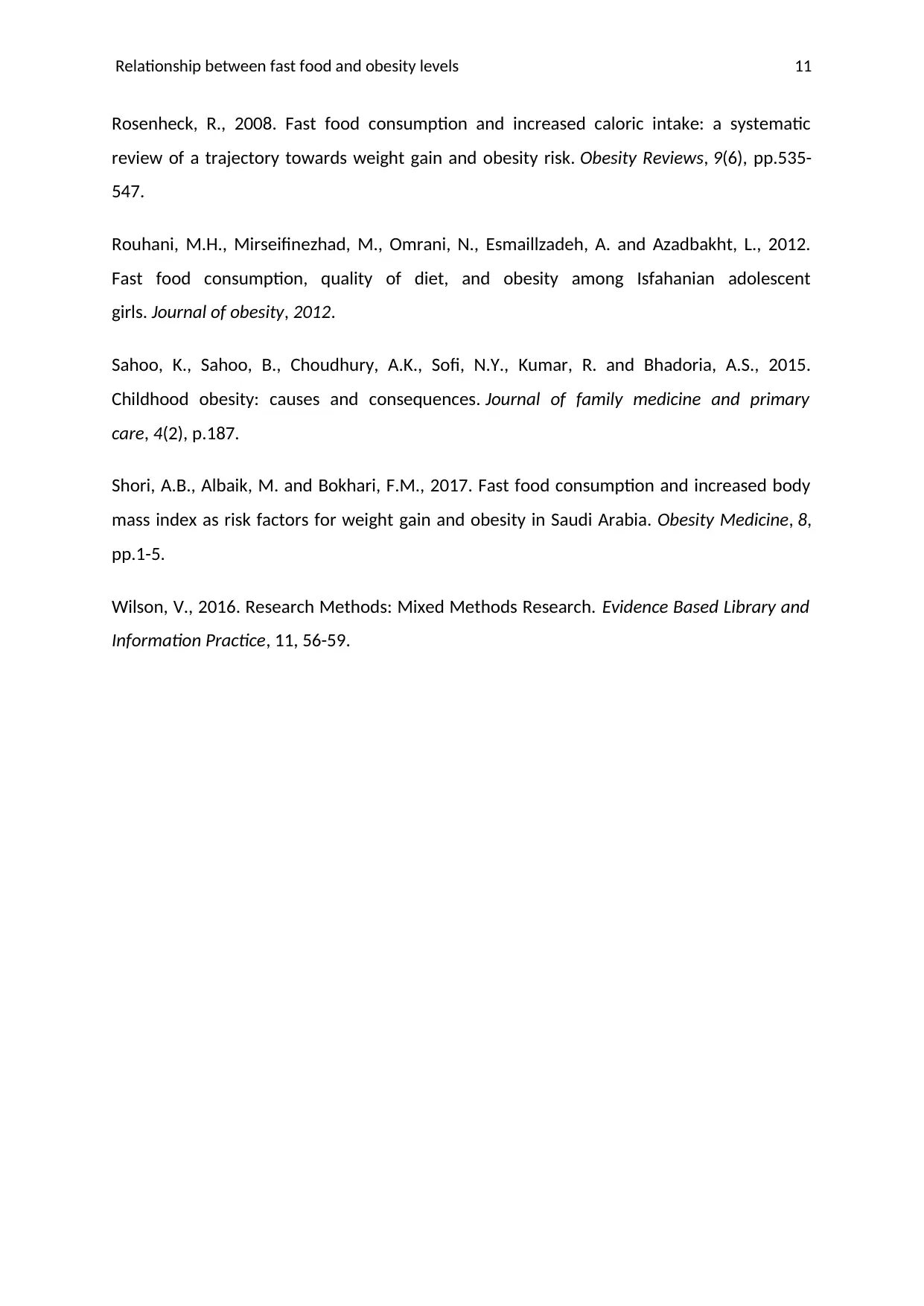
Relationship between fast food and obesity levels 11
Rosenheck, R., 2008. Fast food consumption and increased caloric intake: a systematic
review of a trajectory towards weight gain and obesity risk. Obesity Reviews, 9(6), pp.535-
547.
Rouhani, M.H., Mirseifinezhad, M., Omrani, N., Esmaillzadeh, A. and Azadbakht, L., 2012.
Fast food consumption, quality of diet, and obesity among Isfahanian adolescent
girls. Journal of obesity, 2012.
Sahoo, K., Sahoo, B., Choudhury, A.K., Sofi, N.Y., Kumar, R. and Bhadoria, A.S., 2015.
Childhood obesity: causes and consequences. Journal of family medicine and primary
care, 4(2), p.187.
Shori, A.B., Albaik, M. and Bokhari, F.M., 2017. Fast food consumption and increased body
mass index as risk factors for weight gain and obesity in Saudi Arabia. Obesity Medicine, 8,
pp.1-5.
Wilson, V., 2016. Research Methods: Mixed Methods Research. Evidence Based Library and
Information Practice, 11, 56-59.
Rosenheck, R., 2008. Fast food consumption and increased caloric intake: a systematic
review of a trajectory towards weight gain and obesity risk. Obesity Reviews, 9(6), pp.535-
547.
Rouhani, M.H., Mirseifinezhad, M., Omrani, N., Esmaillzadeh, A. and Azadbakht, L., 2012.
Fast food consumption, quality of diet, and obesity among Isfahanian adolescent
girls. Journal of obesity, 2012.
Sahoo, K., Sahoo, B., Choudhury, A.K., Sofi, N.Y., Kumar, R. and Bhadoria, A.S., 2015.
Childhood obesity: causes and consequences. Journal of family medicine and primary
care, 4(2), p.187.
Shori, A.B., Albaik, M. and Bokhari, F.M., 2017. Fast food consumption and increased body
mass index as risk factors for weight gain and obesity in Saudi Arabia. Obesity Medicine, 8,
pp.1-5.
Wilson, V., 2016. Research Methods: Mixed Methods Research. Evidence Based Library and
Information Practice, 11, 56-59.
⊘ This is a preview!⊘
Do you want full access?
Subscribe today to unlock all pages.

Trusted by 1+ million students worldwide
1 out of 13
Related Documents
Your All-in-One AI-Powered Toolkit for Academic Success.
+13062052269
info@desklib.com
Available 24*7 on WhatsApp / Email
![[object Object]](/_next/static/media/star-bottom.7253800d.svg)
Unlock your academic potential
Copyright © 2020–2025 A2Z Services. All Rights Reserved. Developed and managed by ZUCOL.




